Optimizing Multi-Scenario Water Resource Allocation in Reservoirs Considering Trade-Offs between Water Demand and Ecosystem Services
Abstract
1. Introduction
2. Materials and Methods
2.1. Ecosystem Service Supply and Demand Relationship
2.1.1. Calculation of Ecosystem Service Functions and Values of Reservoirs
2.1.2. The Index of Ecosystem Service Meeting
| ES Types | Methods | Accounting Models | |
|---|---|---|---|
| Regulation services | Flood regulation | Shadow project | : the reservoir’s ultimate storage capacity (m3); : the reservoir’s actual storage capacity (m3); : the cost of average flood storage (CNY/m3), the value is 0.67 in this paper concerning Qi et al. [32]. |
| Supporting services | Carbon sequestration and oxygen release | Industrial generation | : the service value of sequestering carbon; : the service value of releasing oxygen. (CNY/t), 1242; sequestered in plain reservoir(t). cost (CNY/t), 400; : the amount of oxygen released from the reservoir(t). ); , 44/12. , 32/12. |
| Water storage | Market value | : the unit water storage value, 0.611(CNY/m3), referring to Jia et al. [33]. | |
| Provision services | Water supply | Shadow project | : the shadow price of various types of water supply; : the amount of each type of water supply (m3); i = 1,2,3, and 4 indicate the types of water supply, divided into industrial, agricultural, domestic, and ecological water. |
| Cultural services | Social education and scientific research | Willingness to pay | : the population of the service area; : the per capita disposable income of the service area (CNY); : the proportion of disposable income that residents are willing to pay (%). |
2.2. Water Resource Supply and Demand Relationship
2.3. Synergy between ES and WR Supply and Demand
2.4. Water Optimization Allocation Model
2.4.1. Objective Function
2.4.2. Constraints
2.4.3. Model Solution
2.5. Data Prediction and Scenario Setting
2.5.1. ARIMA Prediction Model
2.5.2. Scenario Setting
2.6. Case and Data Source
2.6.1. Case of Datun Reservoir
2.6.2. Data Resource
3. Results
3.1. The Ecological System Service Value of the Datun Reservoir
3.2. Results of ARIMA Model Prediction
3.3. Results of Water Optional Allocation
3.4. Water Allocation under Different Scenarios
4. Discussion
4.1. The Basic Functions and Ecosystem Service Roles of Reservoirs
4.2. Optimization Management of Reservoir Water Allocation and ESVs
4.3. Research Shortcomings and Outlook
5. Conclusions
Author Contributions
Funding
Data Availability Statement
Acknowledgments
Conflicts of Interest
References
- Abdi-Dehkordi, M.; Bozorg-Haddad, O.; Salavitabar, A.; Goharian, E. Developing a sustainability assessment framework for integrated management of water resources systems using distributed zoning and system dynamics approaches. Environ. Dev. Sustain. 2021, 23, 16246–16282. [Google Scholar] [CrossRef]
- Jansson, A.; Folke, C.; Rockstrom, J.; Gordon, L. Linking freshwater flows and ecosystem services appropriated by people: The case of the Baltic Sea drainage basin. Ecosystems 1999, 2, 351–366. [Google Scholar] [CrossRef]
- Yang, Z.; Huang, X.; Fang, G.; Ye, J.; Lu, C. Benefit evaluation of East Route Project of South to North Water Transfer based on trapezoid cloud model. Agric. Water Manag. 2021, 254, 106960. [Google Scholar] [CrossRef]
- Momblanch, A.; Paredes-Arquiola, J.; Andreu, J. Improved modelling of the freshwater provisioning ecosystem service in water scarce river basins. Environ. Model. Softw. 2017, 94, 87–99. [Google Scholar] [CrossRef]
- Fu, B.; Wang, Y.K.; Xu, P.; Yan, K.; Li, M. Value of ecosystem hydropower service and its impact on the payment for ecosystem services. Sci. Total Environ. 2014, 472, 338–346. [Google Scholar] [CrossRef] [PubMed]
- Bekoe, J.; Balana, B.B.; Nimoh, F. Social cost-benefit analysis of investment in rehabilitation of multipurpose small reservoirs in northern Ghana using an ecosystem services-based approach. Ecosyst. Serv. 2021, 50, 101329. [Google Scholar] [CrossRef]
- Costanza, R.; de Groot, R.; Sutton, P.; van der Ploeg, S.; Anderson, S.J.; Kubiszewski, I.; Farber, S.; Turner, R.K. Changes in the global value of ecosystem services. Glob. Environ. Change-Hum. Policy Dimens. 2014, 26, 152–158. [Google Scholar] [CrossRef]
- Martinez-Guerra, E.; Ghimire, U.; Nandimandalam, H.; Norris, A.; Gude, V.G. Wetlands for environmental protection. Water Environ. Res. 2020, 92, 1677–1694. [Google Scholar] [CrossRef]
- Zhao, B.; Li, B.; Zhong, Y.; Nakagoshi, N.; Chen, J.-k. Estimation of ecological service values of wetlands in Shanghai, China. Chin. Geogr. Sci. 2005, 15, 151–156. [Google Scholar] [CrossRef]
- Drius, M.; Bongiorni, L.; Depellegrina, D.; Menegon, S.; Pugnetti, A.; Stifter, S. Tackling challenges for Mediterranean sustainable coastal tourism: An ecosystem service perspective. Sci. Total Environ. 2019, 652, 1302–1317. [Google Scholar] [CrossRef]
- Turner, K.G.; Anderson, S.; Gonzales-Chang, M.; Costanza, R.; Courville, S.; Dalgaard, T.; Dominati, E.; Kubiszewski, I.; Ogilvy, S.; Porfirio, L.; et al. A review of methods, data, and models to assess changes in the value of ecosystem services from land degradation and restoration. Ecol. Model. 2016, 319, 190–207. [Google Scholar] [CrossRef]
- Pittock, J.; Lankford, B.A. Environmental water requirements: Demand management in an era of water scarcity. J. Integr. Environ. Sci. 2010, 7, 75–93. [Google Scholar] [CrossRef]
- Crespo, D.; Albiac, J.; Dinar, A.; Esteban, E.; Kahil, T. Integrating ecosystem benefits for sustainable water allocation in hydroeconomic modeling. PLoS ONE 2022, 17, e0267439. [Google Scholar] [CrossRef] [PubMed]
- Jones, S.K.; Boundaog, M.; DeClerck, F.A.; Estrada-Carmona, N.; Mirumachi, N.; Mulligan, M. Insights into the importance of ecosystem services to human well-being in reservoir landscapes. Ecosyst. Serv. 2019, 39, 100987. [Google Scholar] [CrossRef]
- Guo, Z.; Boeing, W.J.; Borgomeo, E.; Xu, Y.; Weng, Y. Linking reservoir ecosystems research to the sustainable development goals. Sci. Total Environ. 2021, 781, 146769. [Google Scholar] [CrossRef] [PubMed]
- Ho, L.; Goethals, P. Sustainability of Lakes and Reservoirs: Multiple Perspectives Based on Ecosystem Services. Water 2021, 13, 2763. [Google Scholar] [CrossRef]
- Tranmer, A.W.; Weigel, D.; Marti, C.L.; Vidergar, D.; Benjankar, R.; Tonina, D.; Goodwin, P.; Imberger, J. Coupled reservoir-river systems: Lessons from an integrated aquatic ecosystem assessment. J. Environ. Manag. 2020, 260, 110107. [Google Scholar] [CrossRef]
- Hatamkhani, A.; Moridi, A.; Asadzadeh, M. Water allocation using ecological and agricultural value of water. Sustain. Prod. Consum. 2022, 33, 49–62. [Google Scholar] [CrossRef]
- Fu, Y.C.; Zhang, J.; Zhang, C.L.; Zang, W.B.; Guo, W.X.; Qian, Z.; Liu, L.S.; Zhao, J.Y.; Feng, J. Payments for Ecosystem Services for watershed water resource allocations. J. Hydrol. 2018, 556, 689–700. [Google Scholar] [CrossRef]
- Laurita, B.; Castelli, G.; Resta, C.; Bresci, E. Stakeholder-based water allocation modelling and ecosystem services trade-off analysis: The case of El Carracillo region (Spain). Hydrol. Sci. J. 2021, 66, 777–794. [Google Scholar] [CrossRef]
- Su, Q.; Chen, X. Efficiency analysis of metacoupling of water transfer based on the parallel data envelopment analysis model: A case of the South–North Water Transfer Project-Middle Route in China. J. Clean. Prod. 2021, 313, 127952. [Google Scholar] [CrossRef]
- Sun, S.; Zhou, X.; Liu, H.; Jiang, Y.; Zhou, H.; Zhang, C.; Fu, G. Unraveling the effect of inter-basin water transfer on reducing water scarcity and its inequality in China. Water Res. 2021, 194, 116931. [Google Scholar] [CrossRef] [PubMed]
- Hecht, J.S.; Lacombe, G.; Arias, M.E.; Dang, T.D.; Piman, T. Hydropower dams of the Mekong River basin: A review of their hydrological impacts. J. Hydrol. 2019, 568, 285–300. [Google Scholar] [CrossRef]
- Pahl-Wostl, C.; Lukat, E.; Stein, U.; Troeltzsch, J.; Yousefi, A. Improving the socio-ecological fit in water governance by enhancing coordination of ecosystem services used. Environ. Sci. Policy 2023, 139, 11–21. [Google Scholar] [CrossRef]
- Zhao, J.; Ge, Y.; Li, Y.; Li, C. Study on the appropriate standard of eco-compensation based on ecosystem service value in Dawen River basin. J. Arid Land Resour. Environ. 2023, 37, 446–452. [Google Scholar] [CrossRef]
- Safaei, H.; Motlagh, M.G.; Khorshidian, M.; Malmasi, S. Introducing a process to select the appropriate dam compensation option based on ecosystem services. Environ. Dev. Sustain. 2022, 24, 13011–13034. [Google Scholar] [CrossRef]
- Sun, Q.; Wang, J.G.; Zhang, J.; Xing, Z.C. Selecting reservoir reconstruction schemes from an ecological-economic trade-off perspective: Model building and case study. J. Clean. Prod. 2022, 376, 134183. [Google Scholar] [CrossRef]
- Chen, D.; Zhong, L. Review of the value evaluation and realization mechanism of ecosystem services. J. China Agric. Resour. Reg. Plan. 2023, 44, 84–94. [Google Scholar]
- Meng, Y.; Zhang, H.; Jiang, P.; Guan, X.; Yan, D. Quantitative assessment of safety, society and economy, sustainability benefits from the combined use of reservoirs. J. Clean. Prod. 2021, 324, 129242. [Google Scholar] [CrossRef]
- Luo, L.; Yang, L.; Xie, H.; Guan, Z.; Wei, P. Ecosystem service value of mine park under ecological restoration background: A case study of Zijin Mountain in Fujian Province. Chin. J. Ecol. 2022, 41, 2171–2179. [Google Scholar] [CrossRef]
- Wang, J.; Zhai, T.; Lin, Y.; Kong, X.; He, T. Spatial imbalance and changes in supply and demand of ecosystem services in China. Sci. Total Environ. 2019, 657, 781–791. [Google Scholar] [CrossRef] [PubMed]
- Qi, N.; Sun, W.; Kan, H.; Liu, L.; Zou, J.; Pang, Z.; Zhang, G. Evaluation on water-related ecosystem services of Minyun reservoir during 2008-2019. Bull. Soil Water Conserv. 2021, 41, 276–283. [Google Scholar] [CrossRef]
- Jia, Y.; Shen, J.; Wang, H. Research on the confirmation, measurement and form compilation of regional water resources assets. J. Nat. Resour. 2022, 37, 3297–3312. [Google Scholar] [CrossRef]
- Zehtabian, E.; Masoudi, R.; Yazdandoost, F.; Sedghi-Asl, M.; Loáiciga, H.A. Investigation of water allocation using integrated water resource management approaches in the Zayandehroud River basin, Iran. J. Clean. Prod. 2023, 395, 136339. [Google Scholar] [CrossRef]
- Heydari, F.; Saghafian, B.; Delavar, M. Coupled Quantity-Quality Simulation-Optimization Model for Conjunctive Surface-Groundwater Use. Water Resour. Manag. 2016, 30, 4381–4397. [Google Scholar] [CrossRef]
- Wang, J.; Qin, T.; Lv, X.; Ni, Y.; Zhang, Q.; Ma, L. Study of Optimal and Joint Allocations of Water and land Resources for Multiple Objectives. Water Resour. Manag. 2023, 37, 1241–1256. [Google Scholar] [CrossRef]
- Jiao, G.; Chen, S.; Wang, F.; Wang, Z.; Wang, F.; Li, H.; Zhang, F.; Cai, J.; Jin, J. Water Quality Evaluation and Prediction Based on a Combined Model. Appl. Sci. 2023, 13, 1286. [Google Scholar] [CrossRef]
- Ma, H.; Huang, D.; Zhang, J.; Tian, Z. The provincial differences of china’s water use efficiency in recent years: Technological progress or technical efficiency. Resour. Sci. 2012, 34, 794–801. [Google Scholar]
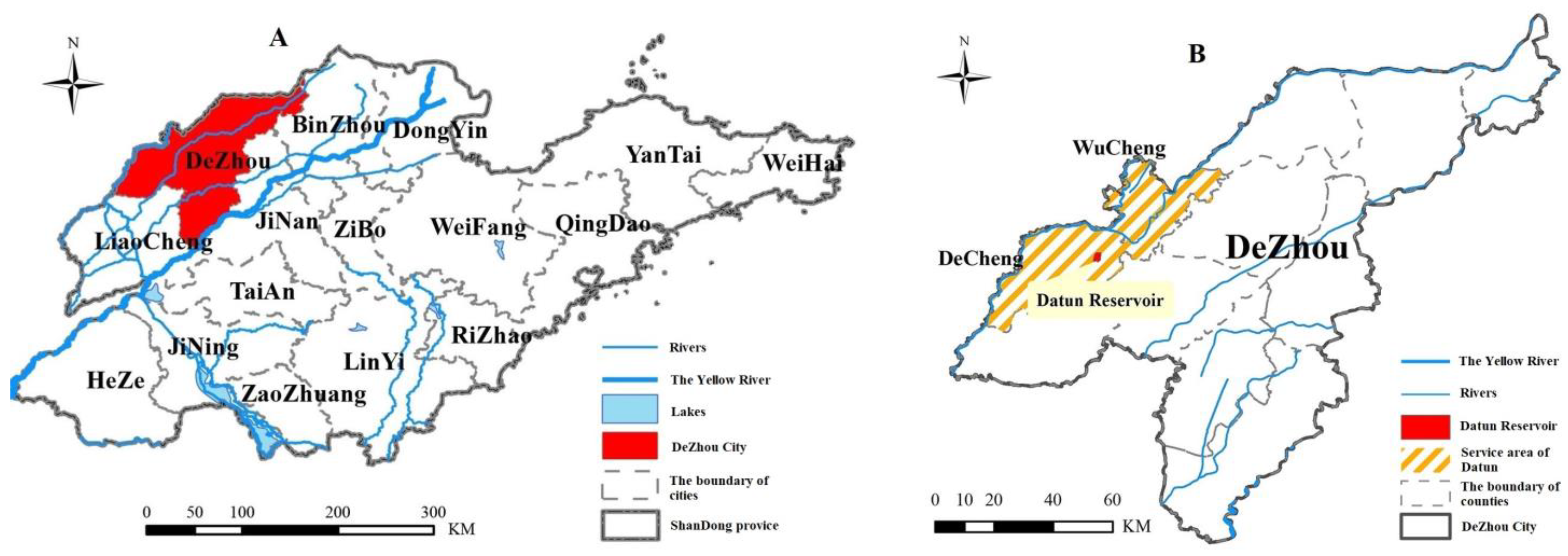
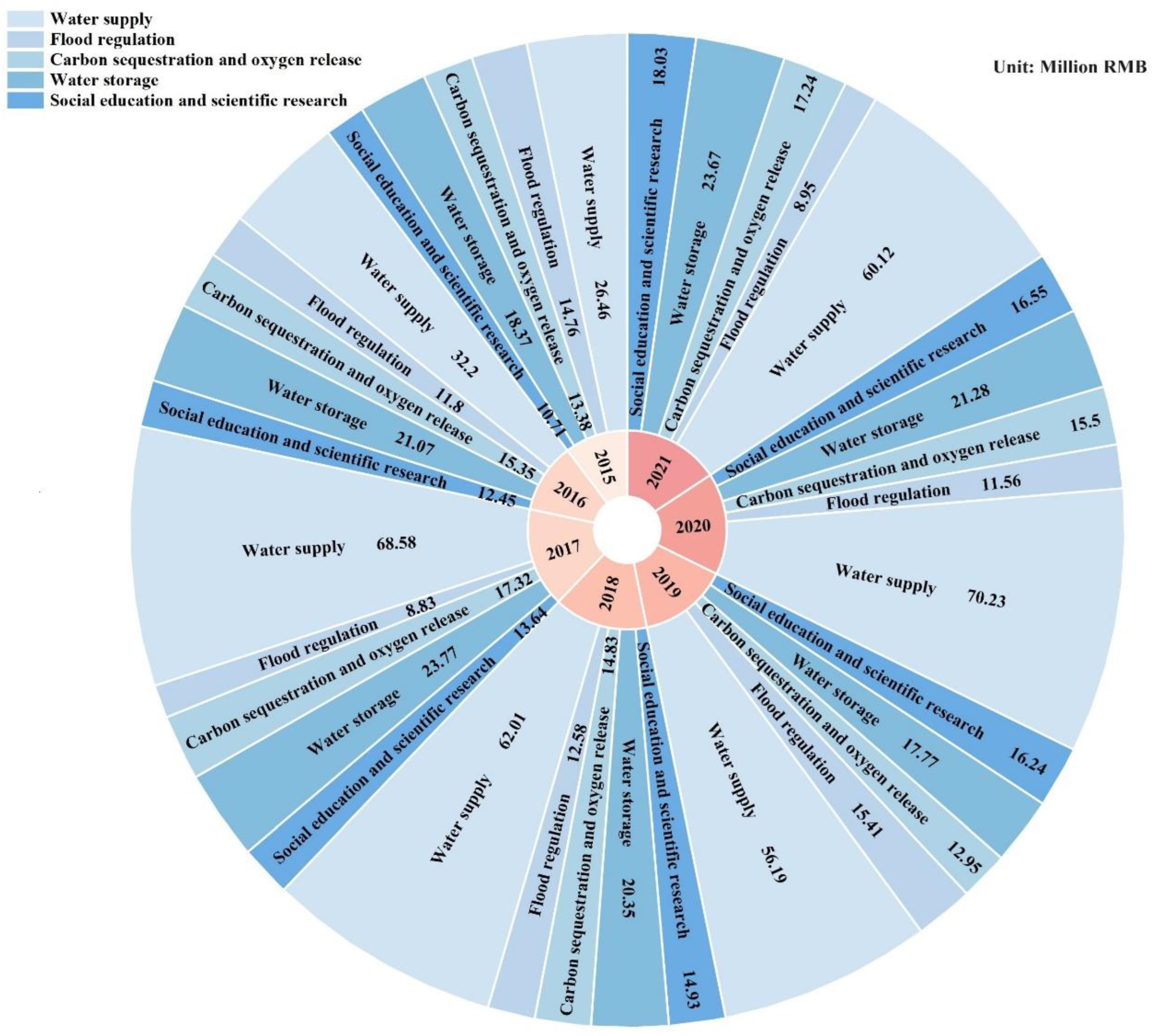
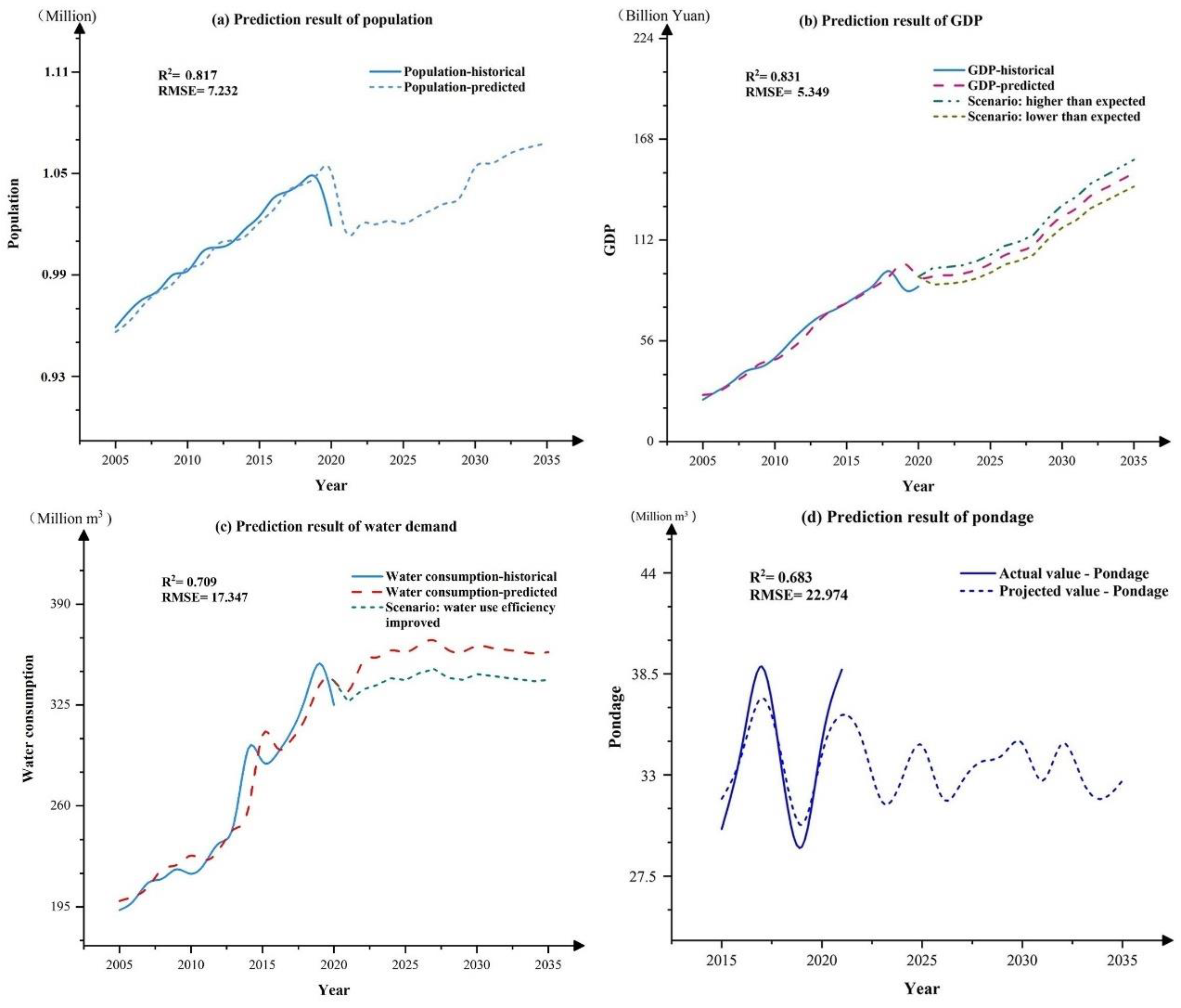
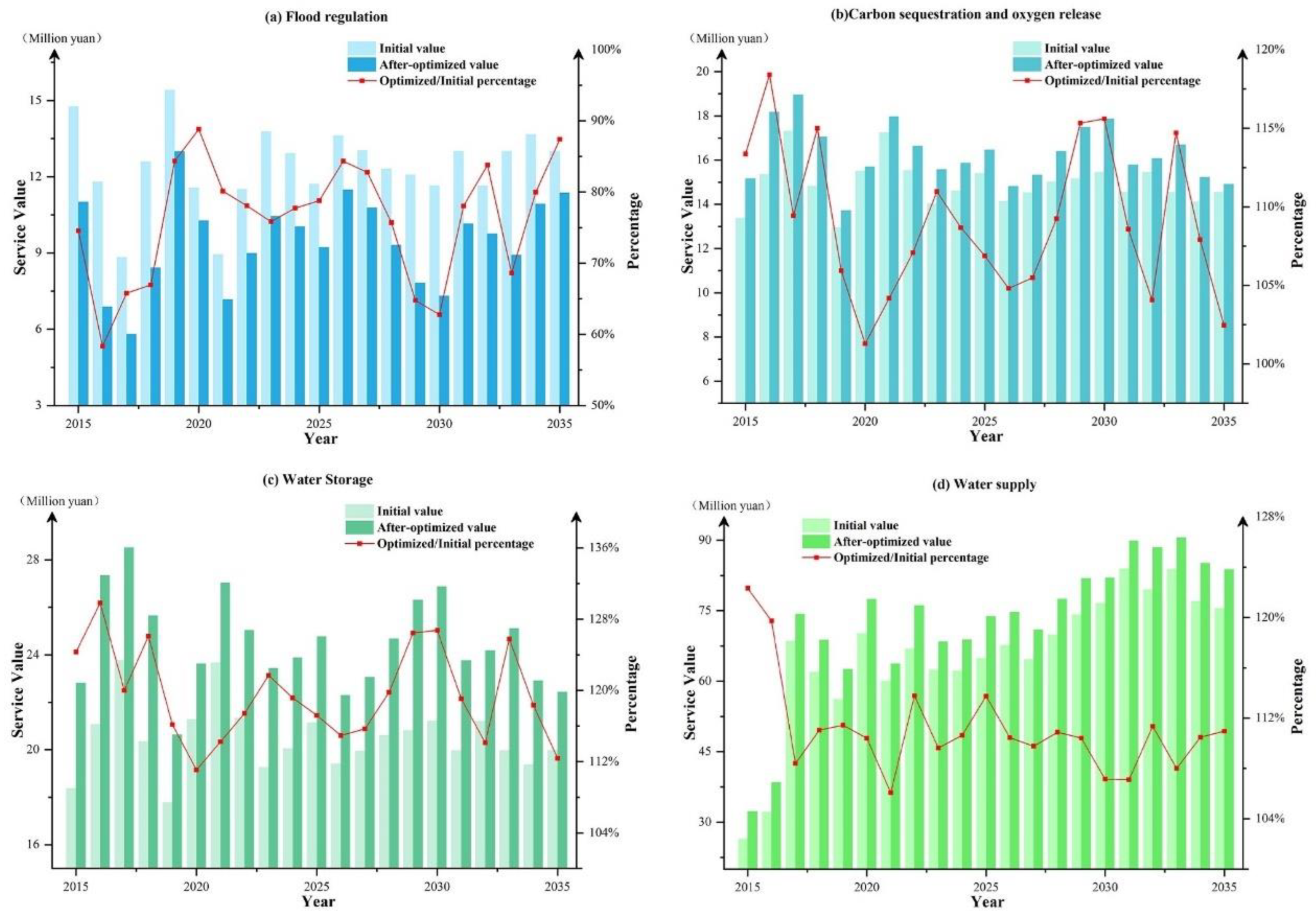



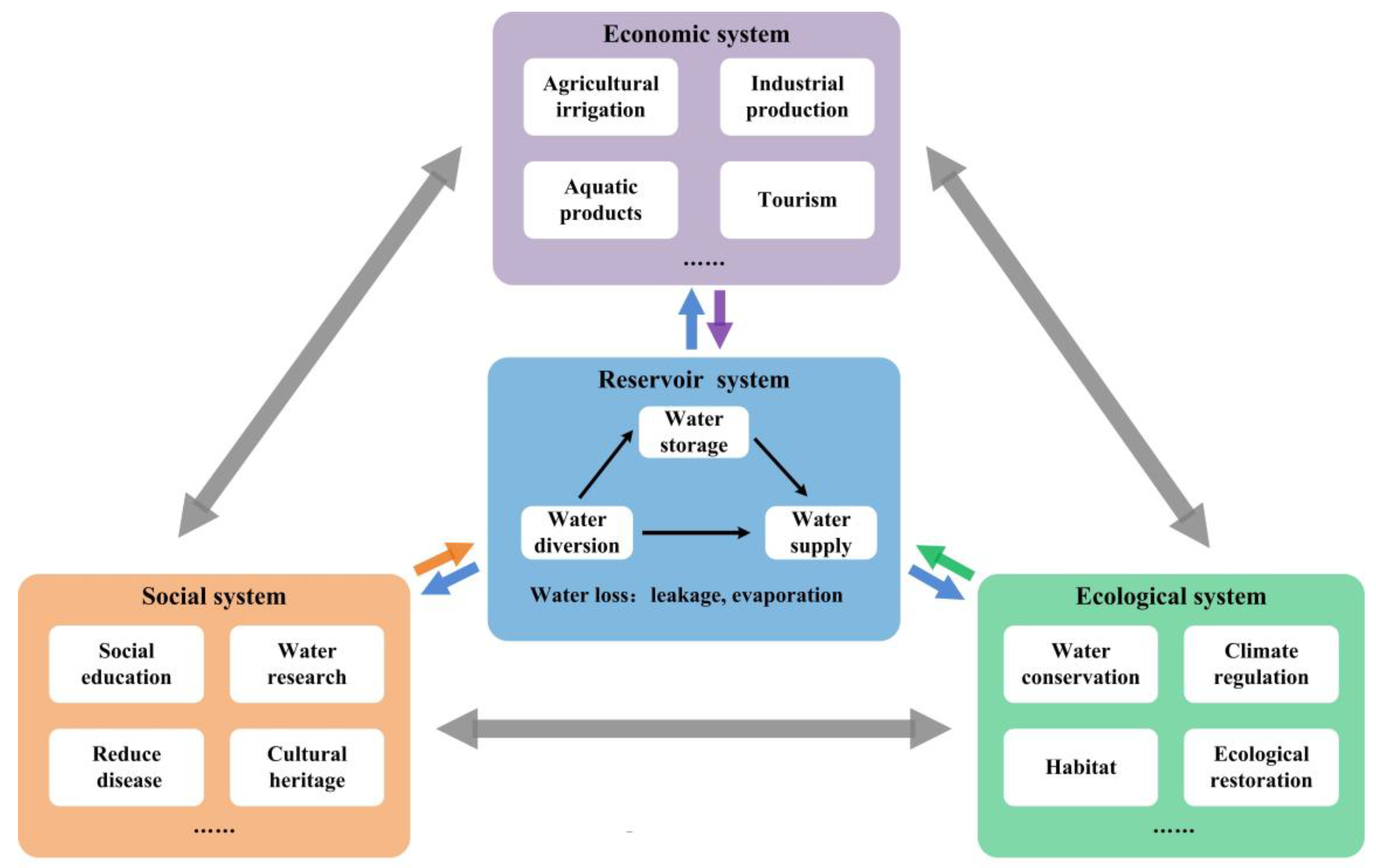
| Scenarios | Instructions | Economic Indicators | Social Water Usage Indicators |
|---|---|---|---|
| 1 | Baseline scenario: based on the predictive model results. | Using predictive results | Using predictive results |
| 2 | High economic growth exceeding expectations with improved water efficiency. | Making upward adjustments to the predictive results, referring to the region’s economic plans. | Make downward adjustments to the baseline predictive results. |
| 3 | Low economic growth below expectations with improved water efficiency. | Making downward adjustments to the predictive results, referring to the region’s economic plans. | Make downward adjustments to the baseline predictive results. |
| Year | Domestic Water Supply | Industrial Water Supply | Pondage | |||
|---|---|---|---|---|---|---|
| Initial | Optimal | Initial | Optimal | Initial | Optimal | |
| 2015 | 2.949 | 3.096 | 7.075 | 7.166 | 30.060 | 34.077 |
| 2016 | 3.352 | 3.519 | 8.847 | 9.085 | 34.484 | 40.829 |
| 2017 | 5.033 | 5.284 | 20.946 | 21.878 | 38.908 | 42.580 |
| 2018 | 6.607 | 6.837 | 16.881 | 17.245 | 33.311 | 38.304 |
| 2019 | 7.141 | 7.598 | 14.144 | 15.124 | 29.090 | 30.817 |
| 2020 | 9.516 | 9.891 | 17.085 | 18.477 | 34.830 | 35.279 |
| 2021 | 7.811 | 8.102 | 14.961 | 16.056 | 38.738 | 40.359 |
| 2025 | 8.473 | 8.597 | 16.114 | 18.374 | 34.603 | 36.984 |
| 2030 | 8.731 | 8.968 | 20.272 | 21.116 | 34.714 | 40.129 |
| 2035 | 10.781 | 11.420 | 17.838 | 19.334 | 32.689 | 33.496 |
| Year | 2015 | 2016 | 2017 | 2018 | 2019 | 2020 | 2021 |
| Initial value | 83.68 | 92.87 | 132.14 | 124.70 | 118.57 | 135.12 | 128.01 |
| Value after optimization | 92.09 | 103.42 | 141.28 | 134.92 | 126.23 | 143.69 | 133.98 |
| Increased percentage | 10.05% | 11.36% | 6.91% | 8.20% | 6.46% | 6.34% | 4.67% |
| Year | 2022 | 2023 | 2024 | 2025 | 2026 | 2027 | 2028 |
| Initial value | 134.47 | 129.23 | 130.36 | 134.54 | 136.84 | 135.40 | 142.35 |
| Value after optimization | 145.99 | 137.64 | 139.22 | 145.68 | 145.36 | 143.41 | 152.44 |
| Increased percentage | 8.57% | 6.50% | 6.80% | 8.27% | 6.22% | 5.91% | 7.09% |
| Year | 2029 | 2030 | 2031 | 2032 | 2033 | 2034 | 2035 |
| Initial value | 147.21 | 150.98 | 158.72 | 155.87 | 159.95 | 154.61 | 154.42 |
| Value after optimization | 158.52 | 160.21 | 166.89 | 166.63 | 169.88 | 164.63 | 163.89 |
| Increased percentage | 7.68% | 6.11% | 5.15% | 6.91% | 6.21% | 6.48% | 6.13% |
| Year | Scenario 1 | Scenario 2 | Scenario 3 | ||||||
|---|---|---|---|---|---|---|---|---|---|
| Domestic | Industrial | Pondage | Domestic | Industrial | Pondage | Domestic | Industrial | Pondage | |
| 2022 | 8.91 | 17.94 | 37.39 | 9.17 | 22.45 | 39.3 | 8.26 | 21.18 | 38.43 |
| 2023 | 8.28 | 17.66 | 34.99 | 8.65 | 21.19 | 38.45 | 7.79 | 19.99 | 37.77 |
| 2024 | 7.88 | 18.12 | 35.66 | 8.29 | 20.16 | 40.13 | 7.46 | 19.02 | 38.9 |
| 2025 | 8.6 | 18.37 | 36.98 | 8.88 | 19.74 | 39.73 | 7.99 | 18.62 | 38.51 |
| 2026 | 8.1 | 19.22 | 33.29 | 8.92 | 21.96 | 34.7 | 8.03 | 20.71 | 32.97 |
| 2027 | 8.28 | 17.62 | 34.44 | 9.14 | 19.76 | 35.17 | 8.22 | 18.64 | 33.41 |
| 2028 | 8.37 | 19.01 | 36.85 | 9.25 | 20.91 | 37.59 | 8.32 | 19.72 | 36.71 |
| 2029 | 9.14 | 20.8 | 39.29 | 9.44 | 24.46 | 42.33 | 8.49 | 23.07 | 41.43 |
| 2030 | 8.97 | 21.12 | 40.13 | 9.08 | 25.81 | 44.14 | 8.17 | 24.35 | 43.94 |
| 2031 | 10.08 | 22.99 | 35.48 | 10.25 | 27.56 | 38.2 | 9.23 | 25.99 | 37.29 |
| 2032 | 9.29 | 22.26 | 36.12 | 9.5 | 24.78 | 40.22 | 8.55 | 23.38 | 38.21 |
| 2033 | 10.52 | 23.8 | 37.49 | 10.81 | 26.18 | 40.16 | 9.73 | 24.7 | 38.15 |
| 2034 | 9.44 | 22.82 | 34.21 | 9.55 | 25.36 | 39.42 | 8.6 | 23.92 | 38.45 |
| 2035 | 11.42 | 19.33 | 33.5 | 11.71 | 20.84 | 38.78 | 10.54 | 19.66 | 37.84 |
Disclaimer/Publisher’s Note: The statements, opinions and data contained in all publications are solely those of the individual author(s) and contributor(s) and not of MDPI and/or the editor(s). MDPI and/or the editor(s) disclaim responsibility for any injury to people or property resulting from any ideas, methods, instructions or products referred to in the content. |
© 2024 by the authors. Licensee MDPI, Basel, Switzerland. This article is an open access article distributed under the terms and conditions of the Creative Commons Attribution (CC BY) license (https://creativecommons.org/licenses/by/4.0/).
Share and Cite
Tao, B.; Sun, Q.; Wang, J.; Zhang, J.; Xing, Z. Optimizing Multi-Scenario Water Resource Allocation in Reservoirs Considering Trade-Offs between Water Demand and Ecosystem Services. Water 2024, 16, 563. https://doi.org/10.3390/w16040563
Tao B, Sun Q, Wang J, Zhang J, Xing Z. Optimizing Multi-Scenario Water Resource Allocation in Reservoirs Considering Trade-Offs between Water Demand and Ecosystem Services. Water. 2024; 16(4):563. https://doi.org/10.3390/w16040563
Chicago/Turabian StyleTao, Bianshiyu, Qiao Sun, Jigan Wang, Jie Zhang, and Zhencheng Xing. 2024. "Optimizing Multi-Scenario Water Resource Allocation in Reservoirs Considering Trade-Offs between Water Demand and Ecosystem Services" Water 16, no. 4: 563. https://doi.org/10.3390/w16040563
APA StyleTao, B., Sun, Q., Wang, J., Zhang, J., & Xing, Z. (2024). Optimizing Multi-Scenario Water Resource Allocation in Reservoirs Considering Trade-Offs between Water Demand and Ecosystem Services. Water, 16(4), 563. https://doi.org/10.3390/w16040563






